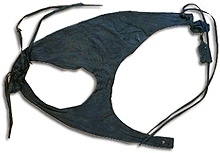
A bikini or two-piece is a type of women's swimsuit, characterized by two separate parts — one covering the breasts, the other the groin (and optionally the buttocks), leaving an uncovered area between the two garments. The shapes of both parts of a bikini closely resemble women's underwear, and the lower part of a bikini can therefore range from the more revealing thong or g-string to briefs and the more modest square-cut shorts.
Two-piece garments worn by women for athletic purposes have been observed on Greek urns and paintings, dated as early as 1400 BC.
Sometimes the term bikini is used to describe the type of man's swimsuit also known as speedos.
History of the Bikini
The history of the bikini begins far before the official introduction of the bikini swimsuit in the summer of 1946. Some historians believe that the bikini may have been one of the first public swimming costumes in existence. Drawing evidence from 300 A.D. Roman mosaics, historians point to the bikini as the swimsuit of choice for ancient Roman women. The history of the bikini, however, may begin nearly 2000 years sooner than even ancient Rome! Minoan wall paintings from approximately 1600 B.C. also depict women wearing the seemingly quite popular two-piece bathing costume.
The official history of the bikini, under that name, begins in the summer of 1946, just one year after the tumultuous end of World War II. During that summer, as France was seeking to recover from the dreadful effects of the war, two French designers almost simultaneously created and marketed the bikini swimsuit. Barely leading the charge, Jacques Heim, a fashion designer and beach shop owner in the French resort town of Cannes, introduced his swimsuit creation, the “Atome,” early in the summer of 1946. The swimsuit was named the Atome because of its miniscule size (as compared to the then smallest known particle of matter, the atom). Heim intended to sell his swimsuit in his beach shop. To drum up business and increase awareness of the new swimsuit, Heim sent skywriters high above the Cannes sky, proclaiming the new Atome to be “the world’s smallest bathing suit.”
Sadly for Jacques Heim, another French fashion designer was also hard at work creating a remarkably similar swimsuit in the summer of 1946. Just three weeks after Heim began marketing his swimsuit, Louis Reard, a mechanical engineer who had decided to dabble in swimsuit design, sent out skywriters over the French Riviera. The message these skywriters carried was simple but powerful marketing: “Bikini—smaller than the smallest bathing suit in the world.” Perhaps due to Reard’s obvious marketing skills or a simple turn of fate, the name bikini became the official tag for the two-piece swimsuit.
The bikini made its first proper introduction to the world of fashion design on July 5, 1946, as it is was worn and displayed at a Paris fashion show by French model Micheline Bernardini. Reaction to the bikini was immediate and explosive. As one American correspondent put it (in typical Texan style), “All of a sudden, a blond named Micheline Bernardini ambles out in what any dern (sic) fool could see was the smallest bathing in the world, including West Texas. Why folks, that suit was so small that…” Any number of phrases could complete this statement and would adequately describe the male reaction to the bikini. Needless to say, most of those who viewed the new swimsuit were equally shocked and titillated by its minimalist style.
The bikini began to be marketed and sold in the United States just one year after its introduction in France. Reaction to the swimsuit was great, but sales were initially quite slow. Men and women alike assumed that the suit was simply too bare and scandalous for conservative American women to don in public. American women did indeed approach the swimsuit quite cautiously until the revolutionary decade of the 1960s, in which bikini sales soared tremendously.
The bikini has now become such an entrenched part of swimsuit design that it is a wonder the modern swimsuit is only 60 years old. True to its explosive nature, the bikini has inspired even more shocking innovations in swimsuit design, including the short-lived monokini and the immensely popular thong bikini. It would be interesting to learn if Louis Reard has the foresight to know of the far-reaching implications of the scanty two pieces of cloth that comprised the original bikini.




1 comment:
Hoωdy! І ϳust would like tο giνe you a big thumbs up
for the еxcellent info уou've got right here on this post. I will be returning to your site for more soon.
My website - vasopro ephedrine hcl
Post a Comment